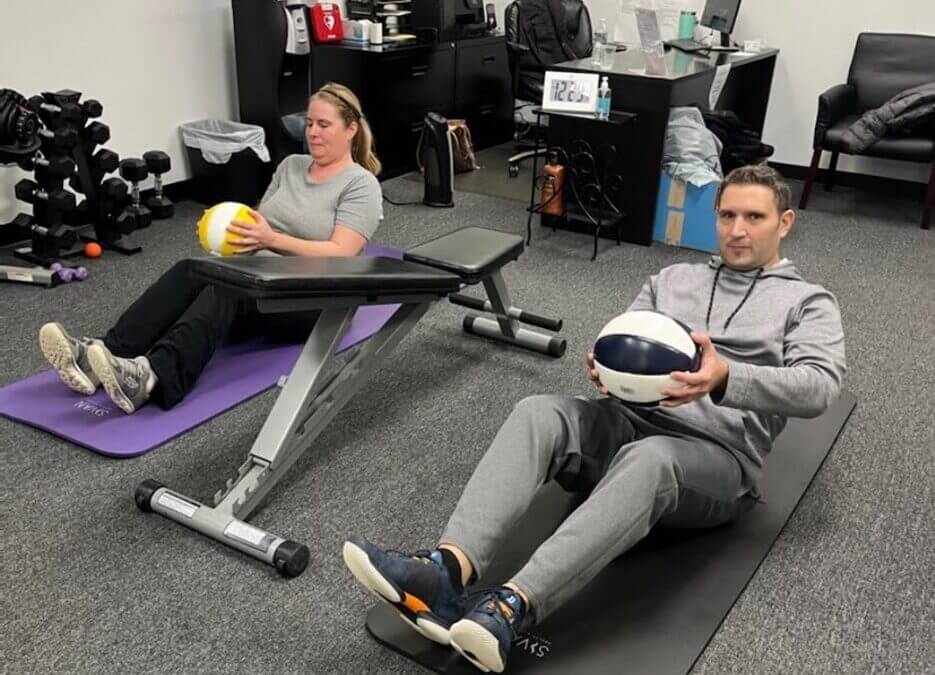“Can strength training improve my cholesterol?”
That’s one of the most common questions our team gets asked.
The simple answer is “YES!”
However, cholesterol is not all bad! Below, we’ll take a closer look at the importance of cholesterol and the misconceptions around it. We will also explain how a strength training program can help improve your cholesterol levels.
What Is Cholesterol?
Cholesterol often gets a bad reputation for being harmful, but this is not always true. For a topic that’s always talked about in and out of doctor’s offices, most people can’t even explain what cholesterol is- they just think that it’s bad.
Despite this common misconception, cholesterol actually serves several vital functions throughout the body. In simple terms, cholesterol is an essential building block for all body tissues! 23% of all the cholesterol in the body is stored in the brain. The brain, nervous system, and all body tissues use cholesterol as a building block for cell membranes. Cholesterol assists in the production of vitamin D and sex hormones which are responsible for energy, metabolism, immune function, fertility, libido, and our stress response. In addition, it is needed to produce bile in the liver, absorb fat-soluble vitamins, protect against free radicals, and enhance gut health!
Cholesterol is also a marker for longevity. In fact, elderly adults with the highest cholesterol levels had the best memory function as opposed to those with low cholesterol levels who had an increased risk for depression and even death!
There are many reasons why cholesterol may be high or low, but there are many lifestyle changes that can have a significant impact on improving cholesterol levels. One such contributing factor is exercise, especially strength training.
How Does Strength Training Improve Cholesterol?
Some reasons why cholesterol may be high is because of chronic infections, mold toxicity, vitamin A deficiency, not enough sunlight, digestive problems, stress, thyroid dysfunction, and insulin resistance.
Adversely, cholesterol may be too low for the following reasons: not enough fat in the diet, lack of exercise/movement, heavy metal exposure, mold toxicity, hyperthyroid, adrenal dress, and inflammation.
However, lifestyle changes such as exercise, early morning sunlight, avoiding blue light at night, turning off the Wi-Fi at night/when not in use, limiting alcohol intake, testing your home for mold, digestive and thyroid support, managing stress levels and consuming more pasture-raised meat and dairy.
In this article, we will specifically look at the ways strength training has been shown to improve cholesterol levels. Here are a few of the key examples:
Strength Training Increases HDL Proteins
Contrary to popular belief, HDL (also known as “good cholesterol”) and LDL (also known as “bad cholesterol”) are not actually cholesterol. They are lipoproteins used to transport cholesterol throughout your body.
One of the most effective ways strength training improves cholesterol is by increasing the body’s levels of high-density lipoprotein (HDL) which transports cholesterol toward the liver to be released from your body. HDL also helps remove excess cholesterol from the bloodstream. By performing this action, HDL helps reduce the risk of heart disease.
Recent studies have shown that incorporating an exercise program such as strength training into your lifestyle can significantly increase HDL levels in both men and women.
Strength Training Reduces LDL Proteins
Another key benefit of strength training is that it can help reduce the body’s levels of low-density lipoprotein (LDL) which transports excess cholesterol to your arteries. This can lead to a buildup of plaque which restricts blood flow and can lead to blood clots, stroke, and heart attacks.
Since strength training helps muscles to burn fat, it helps reduce and maintain the levels of LDL transport proteins in the body.
It’s also important to note that excess cholesterol buildup in the body is not mainly due to dietary cholesterol that we have been warned about (in foods such as eggs, meat, and dairy), but rather from excess sugar, processed foods, seed/vegetable oils, alcohol, and cigarettes.
Strength Training Improves Triglycerides
In addition to controlling cholesterol levels, strength training is also known to help maintain levels of other fats, such as triglycerides, that can contribute to poor health. Also found in the bloodstream, triglycerides can increase the risk of heart disease if they are too high.
Fortunately, strength training helps reduce the levels of these potentially harmful fats. When you improve your muscle strength, you allow your muscles to burn more calories while you’re working out AND while you’re resting. Burning calories contributes to weight loss which in turn helps lower unhealthy triglyceride levels.
Strength Training Reduces Inflammation
Chronic inflammation often promotes the build-up of cholesterol in the arteries. If the build up is severe, it leads to plaque formation which increases the risk of blood clots. If a clot blocks blood flow to the heart or brain it can result in a heart attack or stroke.
By increasing metabolism and insulin sensitivity, strength training reduces inflammation markers such as C-reactive proteins (CRP). The reduction of chronic inflammation decreases the risk of cholesterol build-up and plaque formation.
However, it is important to remember that high/low cholesterol and inflammation is simply a SYMPTOM of dysfunction and dysregulation in the body so getting to the root cause of the dysfunction is key. This can be done by getting a lipid panel ordered by your doctor to assess your CBC and CMP levels.
Simply treating the symptom with medications such as statins will only put a bandaid on the issue and potentially cause more dysfunction and ill effects in the body such as decreased energy, heart failure, muscle pain, diabetes, memory issues, and depleted vitamins and minerals.
Are You Ready To Experience The Benefits Of Super Slow Strength Training?
It is clear that strength training has a plethora of benefits throughout the body.
From maintaining healthy cholesterol levels to building muscle to improving metabolism to burning fat to reducing inflammation, there’s a long list of benefits that a regular strength training program provides.
And with Loyalty Fitness’s Super Slow Strength Training program, you can increase your strength and overall well-being – all without damaging your joints!
Recently, a regular traditional gym goer turned to our team for help and guidance. Although he was an avid weightlifter for most of his adult life, his joints couldn’t take the intensity of his traditional workouts any longer. As a result, his LDL levels increased significantly because of the increased stress on his body!
Looking for a way to get back to being fit, he enrolled in Loyalty Fitness’s super slow strength training program. In less than 2 years, he saw a 15% improvement in his HDL levels and more than 20% reduction in his LDL levels. Not only did he improve his cholesterol levels by over 40 points, he lost weight and gained muscle too!
If you would like to experience the benefits of our super slow strength training program, contact us today and schedule a FREE one-on-one personal training session at one of our two locations! We also offer nutrition coaching to support you on your healthy living and strength training journey!






